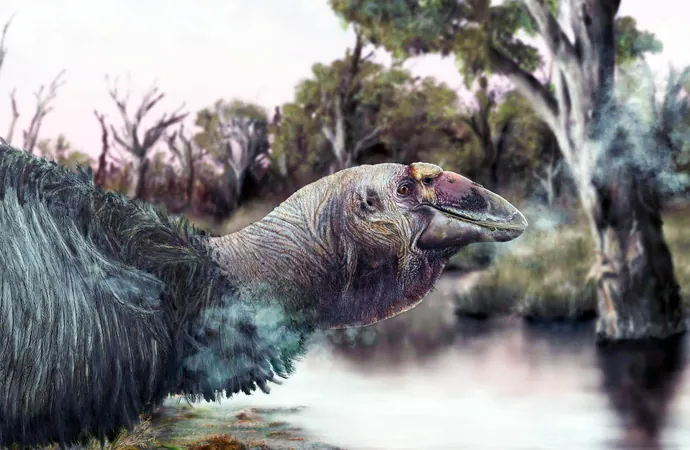
Unearthing the Thunder: The Astonishing Discovery of an Extinct Giant Bird's Skull
2025-05-28
Author: Ling
Picture this: the Australian outback once echoed with the thunderous footsteps of birds towering over humans and weighing more than five times a cassowary! For years, these enormous creatures, known as dromornithids, were only whispers in the scientific community, known primarily from fragmented bones.
But a groundbreaking discovery has just turned our understanding on its head! A newly found skull from the dry bed of Lake Callabonna is revealing a wealth of information about the last of this majestic lineage, Genyornis newtoni.
The Incredible Lake Callabonna Find
Once a shallow oasis in the heart of South Australia, Lake Callabonna became a natural trap as drought diminished its waters, turning its mudflats into a death trap for unsuspecting beasts. Over time, countless large creatures ventured into its depths, only to become ensnared in salt-rich sediments that remarkably preserved their remains.
After years of exploration, researchers struck gold in 2019 when they unearthed a nearly intact cranium alongside limb bones characteristic of Genyornis. This represented a significant leap towards understanding this colossal bird.
The Thunder Bird: A Giant Goose on Steroids
Imagine a bird with the jaw of a parrot but shaped like a goose, equipped with the strength to crush tough plants and fruit. That’s Genyornis newtoni in a nutshell! Weighing about 230 kg (507 lb), this massive bird outclassed today's heaviest ground dwellers with legs strong enough to outrun many Ice Age predators.
Yet, unlike ostriches, it wasn’t built for sprinting. Instead, it featured a stocky build similar to an oversized, flightless goose!
Unraveling the Mysteries of Avian Evolution
Traditionally, dromornithids were thought to be closely related to emus and ostriches due to their flightless nature. However, the new skull evidence suggests a different lineage.
According to researcher Phoebe McInerney, the unique features of Genyornis position it as an evolutionary cousin to modern waterfowl, bridging ancient gaps in our understanding of avian ancestry.
The Bird's Powerful Bite and Unique Ecosystem
Equipped with a parrot-like hinge for efficient biting, Genyornis wielded one of the most powerful beaks in the bird kingdom, aimed at feasting on aquatic plants and fruits. Its lifestyle likely revolved around the lush environments that once dotted Lake Callabonna.
Ancient reeds and fish-filled pools painted a vibrant picture of its habitat, and adaptations such as bone structures protecting soft tissue hint at a well-adapted life for thriving in water.
Lessons from the Past: The Rise and Fall of Genyornis
Despite thriving for tens of millions of years, Genyornis faced a tragic downfall around 45,000 years ago. Climate change, habitat destruction, and the arrival of early human hunters may have collectively pushed these magnificent creatures to the brink.
This recently uncovered skull not only enriches Australia's fossil narrative, it also reinforces essential lessons about conservation today. If such resilient species can succumb to environmental changes, what does that mean for our planet's future?
The complete study, detailing this monumental find and its implications, has been published in the journal Historical Biology. This new evidence offers a profound reminder of the potential that lies in every fossil, waiting to reshape our understanding of the natural world.


 Brasil (PT)
Brasil (PT)
 Canada (EN)
Canada (EN)
 Chile (ES)
Chile (ES)
 Česko (CS)
Česko (CS)
 대한민국 (KO)
대한민국 (KO)
 España (ES)
España (ES)
 France (FR)
France (FR)
 Hong Kong (EN)
Hong Kong (EN)
 Italia (IT)
Italia (IT)
 日本 (JA)
日本 (JA)
 Magyarország (HU)
Magyarország (HU)
 Norge (NO)
Norge (NO)
 Polska (PL)
Polska (PL)
 Schweiz (DE)
Schweiz (DE)
 Singapore (EN)
Singapore (EN)
 Sverige (SV)
Sverige (SV)
 Suomi (FI)
Suomi (FI)
 Türkiye (TR)
Türkiye (TR)
 الإمارات العربية المتحدة (AR)
الإمارات العربية المتحدة (AR)